| US Manned Spacecraft History And Photography |
STS-130 Endeavour
Space Shuttle Launch
February 8, 2010
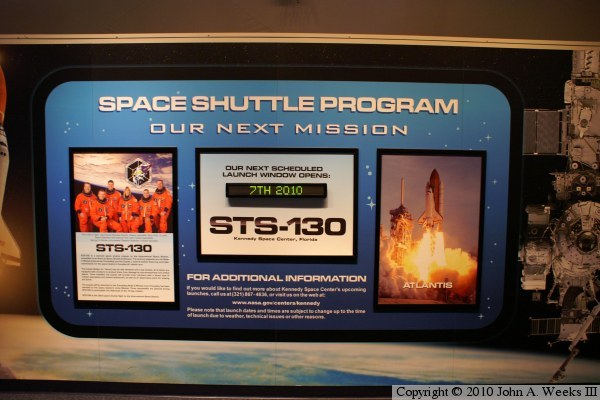
Our photo tour of the launch of Space Shuttle OV-105 Endeavour on the STS-130
mission begins at the Shuttle Information Center at the KSC Visitor Center.
This photo is the shuttle status board, which is indicating that the launch
window for STS-130 opens on February 7, 2010. This mission will carry the
Tranquility module and the Cupola to the International Space Station. STS-130
is expected to be the last night shuttle launch and the first of the final
5 planned shuttle flights.
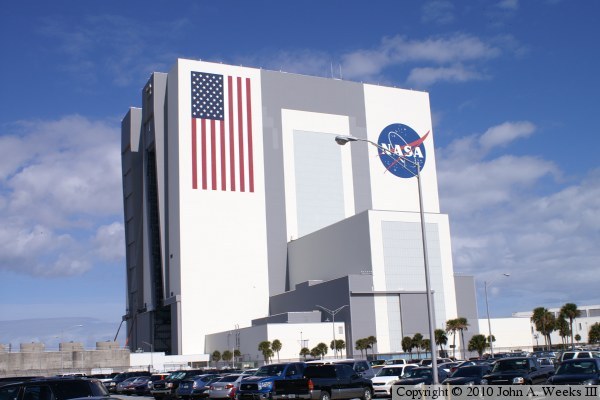
A shuttle flight starts here at the Vehicle Assembly Building. Standing 525
feet tall, it is the largest single story building in the world. Endeavour
was serviced and prepared for flight in bay 2 of the nearby Orbiter
Processing Facility. It was moved to the VAB bay 1 on December 11, 2009.
Endeavour was then mated to an external fuel tank and two solid rocket
boosters to form a shuttle stack. If you look closely, you can see that
the tall door is open on one of bays of the VAB. NASA was preparing to
move the launch tower for the Constellation program into the building. The
shuttle stack is much shorter than either the Saturn rockets or the Ares
rocket, so these doors are rarely opened this far. In fact, this might
have been the first time that this set of doors have been opened this far
since the 1970s.
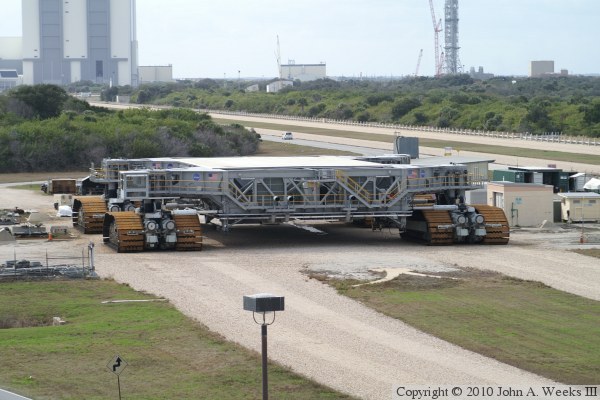
This is the crawler-transporter that carried the shuttle stack out to launch
pad 39A. Endeavour was rolled out of the VAB on January 6, 2010. The 3.4
mile trip to pad 39A took just shy of 6-1/2 hours. Built in 1965, the two
crawler-transporters remain the largest self-powered tracked vehicles on the
planet. They move just 42 feet on a gallon of fuel.
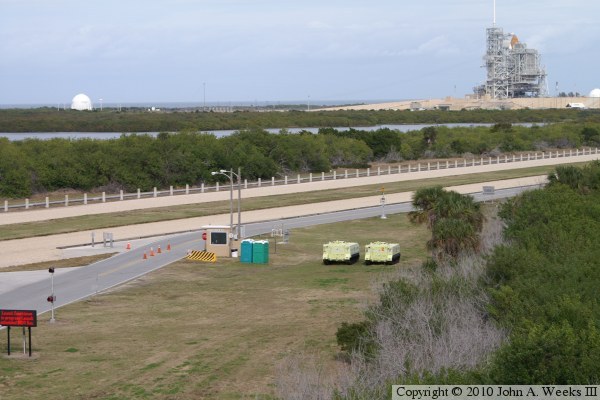
The photo above is the crawler path leading to launch pad 39A. This location
is just east of the point where the crawlerway to pad 39B splits off to the
north. The crawlerway consists of two parallel 40-foot wide lanes separated
by a 50-foot divider. The lanes are built from several different layers of
material 8-feet deep topped by 8 inches of gravel from the Tennessee River.
The two green vehicles sitting by the security checkpoint leading to pad 39A
are M113 armored personnel carriers. NASA has four APCs. Vehicles #1 and #2
are pictured above. Vehicle #3 is sitting at the launch pad to be used for
crew escape in the event of a launch problem. Vehicle #4 is 1/2 mile to the
north at the security helipad to be used by a chopper crew and EMTs.

This is Endeavour sitting on launch pad 39A as seen from the complex 39C
viewing gantry. The gantry is 6,400 feet (1.2 miles) west-southwest of pad
39A. The top of the external tank (brown) and a solid rocket booster (white)
is visible. The shuttle is in front of the tank and boosters in this view,
but is totally obscured by the rotating service structure. The RSS wraps
around the shuttle to provide a clean room for installing cargo into the
vehicle. The RSS is rolled back away from the shuttle about 18 hours
prior to launch as part of the pre-flight close-out.
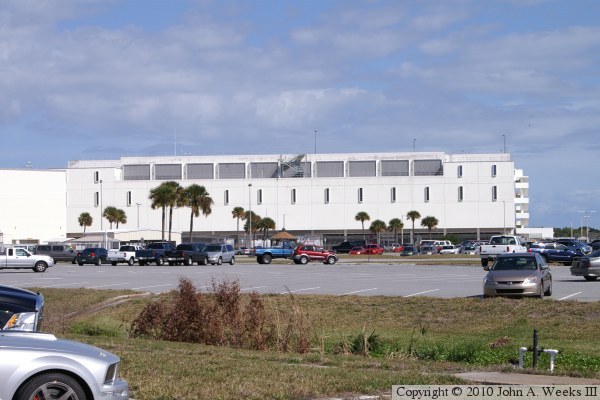
This building, located next to the VAB, is the Launch Control Center. It
contains the firing room where the shuttle launch is initiated. Crew
families are allowed to watch the launch from the top of this building.
The press and VIP viewing area is located across the street from the LCC.
This is the closest launch viewing site available at just over 3 miles from
pad 39A.

This is a replica of the firing room that is part of the tour at the Saturn V
Center. The room layout is the same as the real firing room. This
equipment was used to launch the Saturn rockets in the 1960s and
1970s.
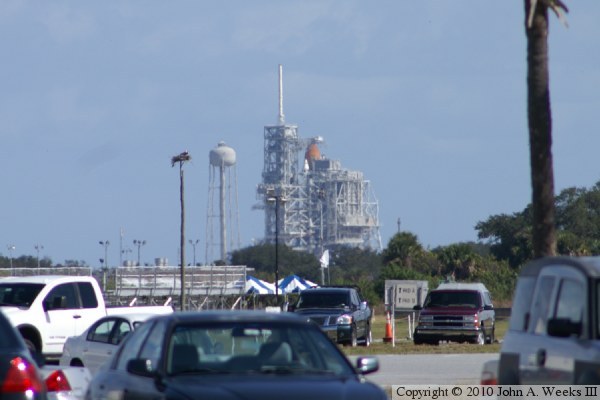
This is the view of launch pad 39A from the parking lot of the VAB. The
tents and bleachers are part of the VIP viewing area. Pad 39A is just over
3 miles to the east of this location. Note the eagle nest on the light
pole just to the left of the water tank. The tiny white dot at the top of
the nest is the head of an adult eagle tending to several chicks in the nest.
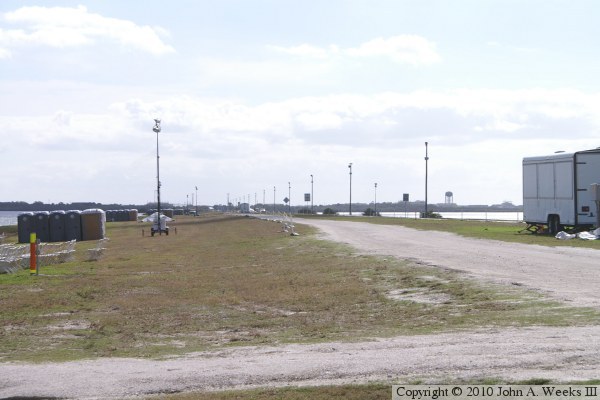
I was able to obtain a causeway viewing pass for the STS-130 launch. This
area is located on the north side of the NASA Causeway over the Banana River
that connects between the Kennedy Space Center and the Cape Canaveral Air
Force Station. This location is 6-3/4 miles due south of pad 39A, making it
the closest viewing location available to the public. At one time, the
public could request vehicle passes to drive out to the causeway for
launch events. However, since 9/11, access is available only by bus from
the visitor center, and it requires going through several layers of
security.
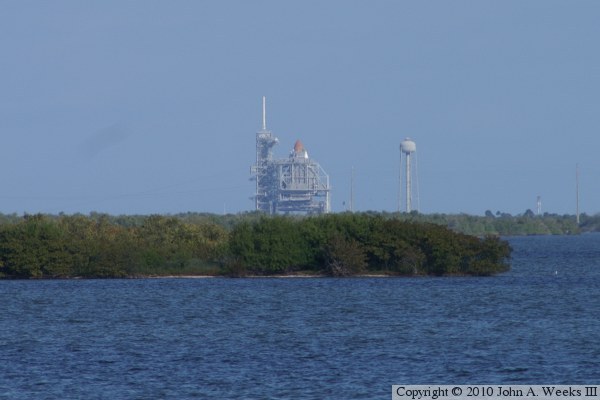
This is the view of launch pad 39A from the NASA Causeway viewing area.
The pad is nearly 7 miles away. The shuttle is on the near side of the
stack, but is obscured by the Rotating Service Structure. The water tower
near the pad is part of the launch pad sound suppression system. It holds
300,000 gallons of water, plus there is another 100,000 gallons of water
in the piping system. This water is dumped onto the pad within 21 seconds
starting at T minus 6 seconds. Without this water dump, sound waves would
bounce off of the pad and destroy the shuttle before it clears the launch
tower.
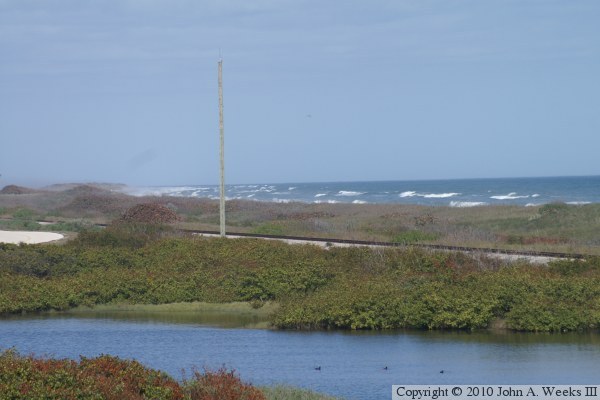
This is a view of the Atlantic Ocean from the USAF camera platform located
northeast of the launch pad 39 complex. Note the rough surf and the high
waves breaking along the shore. High winds were a concern in the days
leading up to the launch. The winds were routinely gusting from 10 to 25
miles per hour. The shuttle has a launch rule set at 22 miles per hour.
This is to prevent winds from blowing the shuttle into the launch tower
at lift-off. Wind is also a concern for sheer stress on the stack in
flight, and for any difficulty in landing the shuttle on the nearby runway
in the event of a launch abort.

This is the Endeavour shuttle stack as seen from the USAF camera platform
located 5,000 feet (just short of mile) to the northeast of pad 39A. This
is the closets public view of the shuttle when it is on the launch pad. The
orbital vehicle is on the far side of the stack giving us a view of the
external tank and solid rocket boosters. This view is looking directly
into the bright midday sun. The sun is low in the sky during February,
making photography from this location even more challenging.
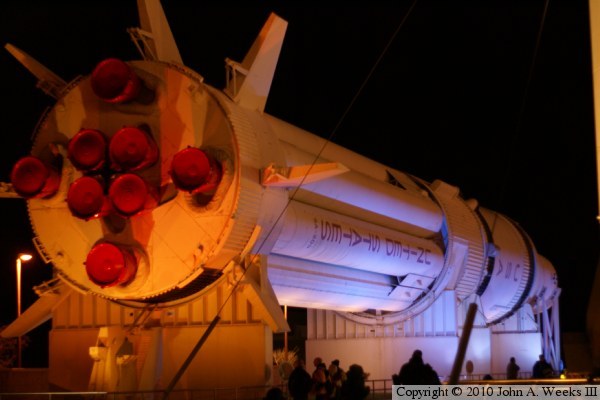
The shuttle launch experience starts here at the Kennedy Space Center
Visitor Center. The visitor center was up and running all night long.
You could watch the launch from the visitor center, from the astronaut
hall of fame, or, if you had a causeway pass, you could board a bus to
head out to the causeway viewing area. There were video screens set up
at the center for NASA TV, public affairs audio was piped in, and officials
held hourly status briefings. The viewing area was located between the
IMAX theater and the rocket garden near this huge Saturn IB rocket. The
Saturn IB boosted several Apollo flights into orbit including Apollo 7,
Skylab 2, Skylab 3, Skylab 4, and the final Apollo flight called ASTF.
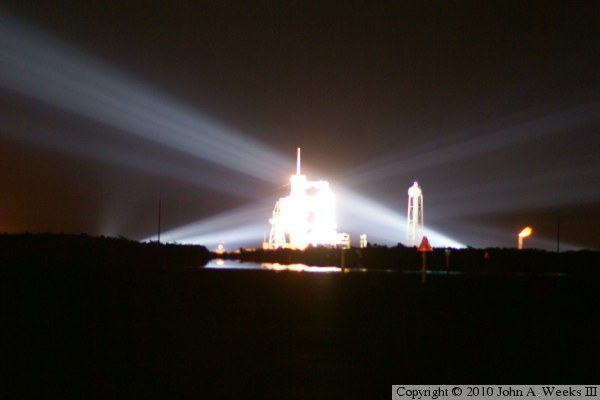
This is the view of the shuttle stack on launch pad 39A on the morning of
February 7, 2010. The vantage point is the NASA Causeway over the Banana
River located a bit less than 7 miles due south of the pad. Most of this
distance is over open water, followed by a swath of trees. The pad structure
is elevated making the stack visible above the treeline. I intentionally
overexposed this photo to highlight the beams of light that are illuminating
the launch pad.

This is a another view of Endeavour sitting on launch pad 39A
only minutes before the first launch attempt on February 7, 2010. This is
our first view of the orbiter given that the RSS has been rolled back out of
the way. The launch odds were given at 70% in the days leading up to the
first lift-off window due to high winds. That was upgraded to 80% the day
before launch. However, a bank of clouds started to roll in the night of
the launch. The odds were given as 65% at 9PM, then 50% at midnight, and
35% at 2AM. The countdown continued to the built-in hold at T minus 9
minutes. The conditions were cycling between go and no-go every 5 minutes
or so. NASA called a scrub at the end of the built-in hold at 4:30 AM.
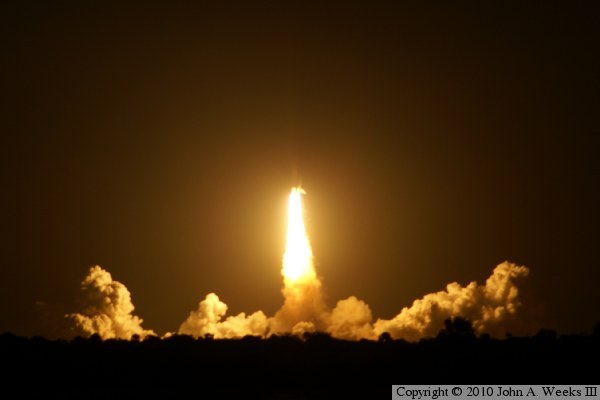
Shortly after calling for the scrub, NASA suggested that they might try
again on Monday morning at 4:14 AM. The weather forecast was not favorable,
nor was it looking promising for Tuesday. Conditions improved throughout the
day on Sunday. NASA announced at 6:30 PM that they had decided to start
filling the fuel tank on Endeavour, an activity that would take 3 hours and
cost $500,000. That is generally a sign that the weather models are looking
favorable. As launch time was nearing, there was a cloud deck, but it was
rapidly thinning out and breaking up. Then an issue developed at the
transatlantic abort site. But when NASA reached the end of the built-in
hold at T minus 9, everything was looking good. Lift-off occurred right at
4:14 AM.
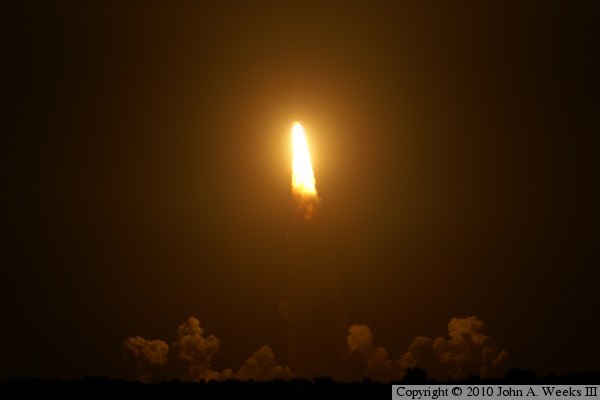
The shuttle flame is about 1,000 feet long, putting the stack about 3,500
feet above the ground in this photo. Night photography requires patience,
often involving taking several shots using different settings in a process
called bracketing. The key is using a tripod and doing longer exposures.
That is difficult in this case because the shuttle is moving so fast that it
would quickly move out of the view finder. In addition, the movement would
cause a blurry photo. Distance shots are even more difficult because the
lenses have higher F-numbers and need longer exposures. Finally, there is no
way to practice this in advance—you only get one shot at the event. All
of these photos perhaps could have used a little more exposure. The smoke
cloud shows up well in the photo above, but there wasn't as much light in
this photo to show the smoke cloud to its best advantage.
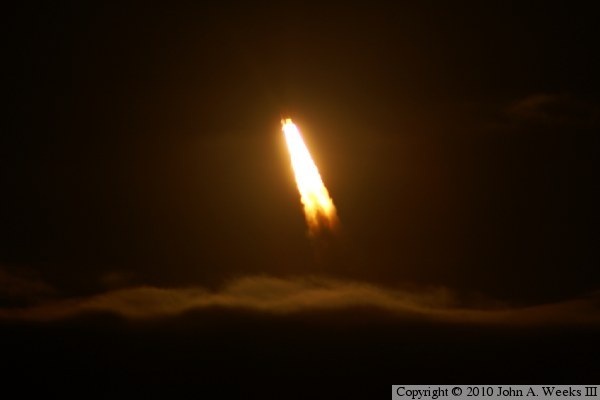
There was a layer of clouds at about 5,000 feet. In this view, the shuttle
has punched through the clouds and is starting to arc over to the northeast.
These launch photos were taken from the Indian River causeway just north of
downtown Titusville. I was parked at the wildlife refuge fishing pier, and
I walked across the causeway onto a dike that was built to support a bridge
construction project. This location was 11-1/2 miles almost due west of
launch pad 39A.

Assuming all goes according to plan, Endeavour will land at the Shuttle
Landing Facility on or about February 20, 2010. This photo is the air traffic
control tower at the shuttle landing strip. While the public is not invited
to watch shuttle landings, this building has several decks for family members,
space program officials, VIPs, and media. Also note the viewing stands
set up on the far side of the building.
|

